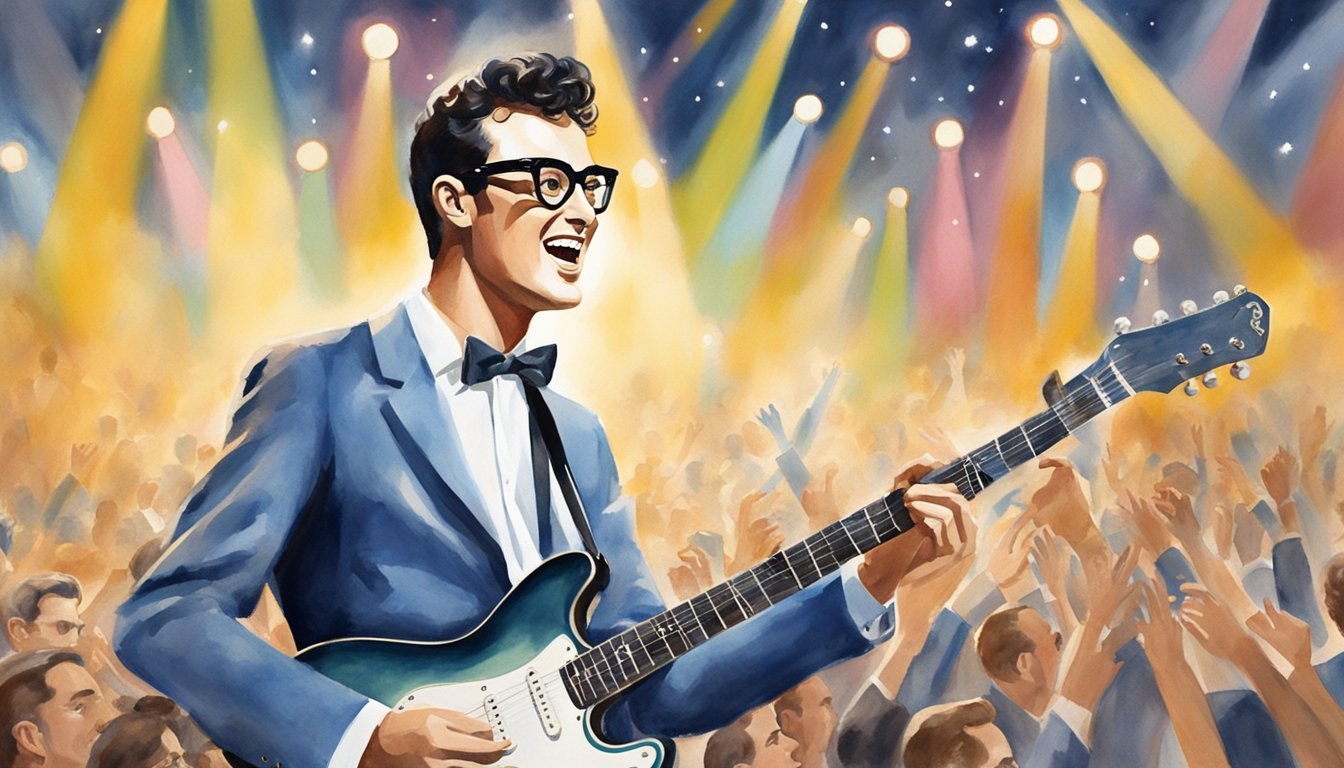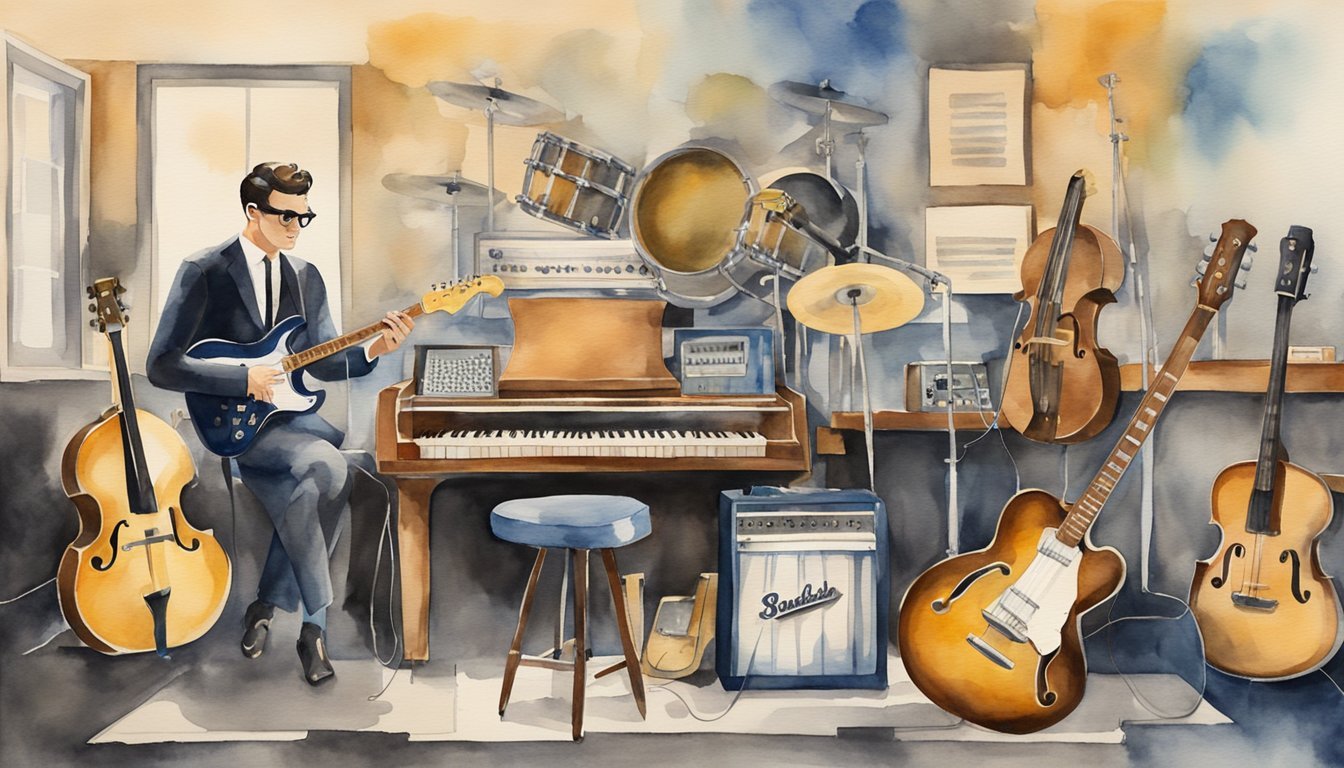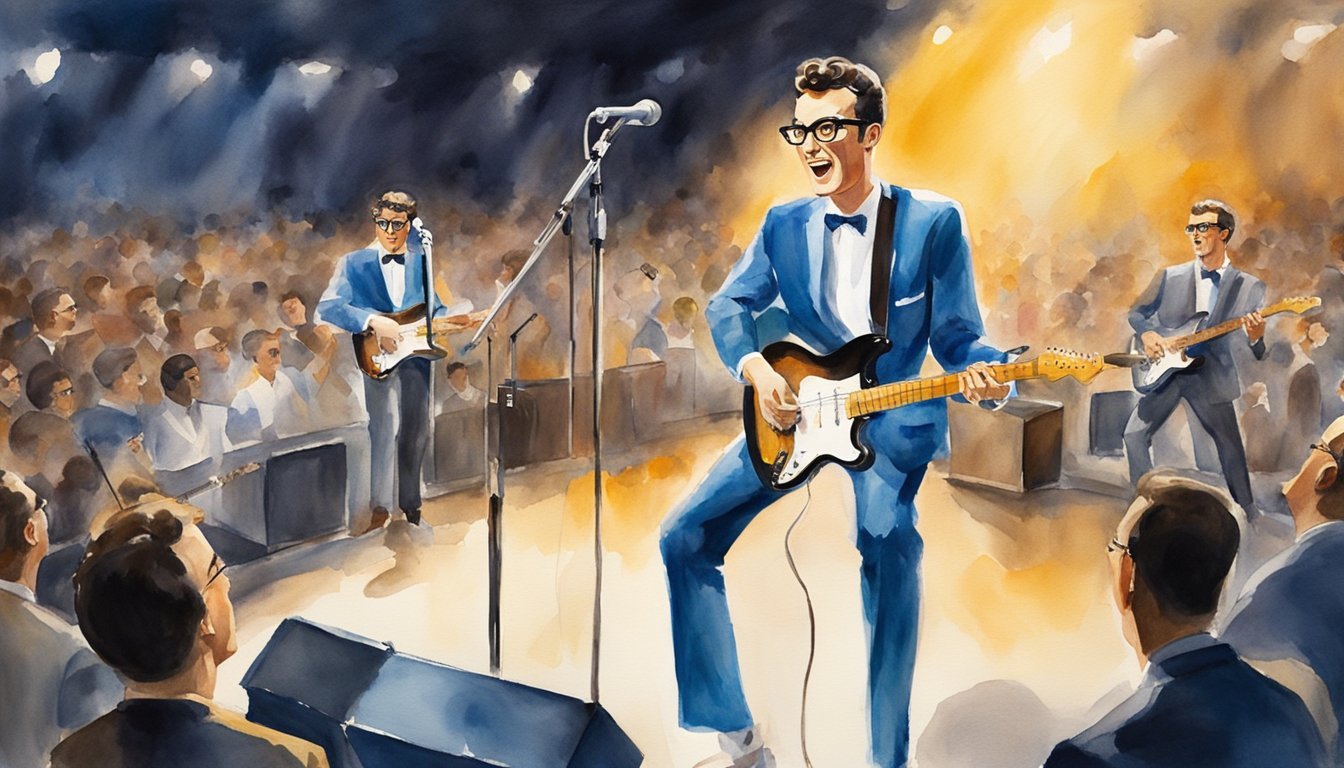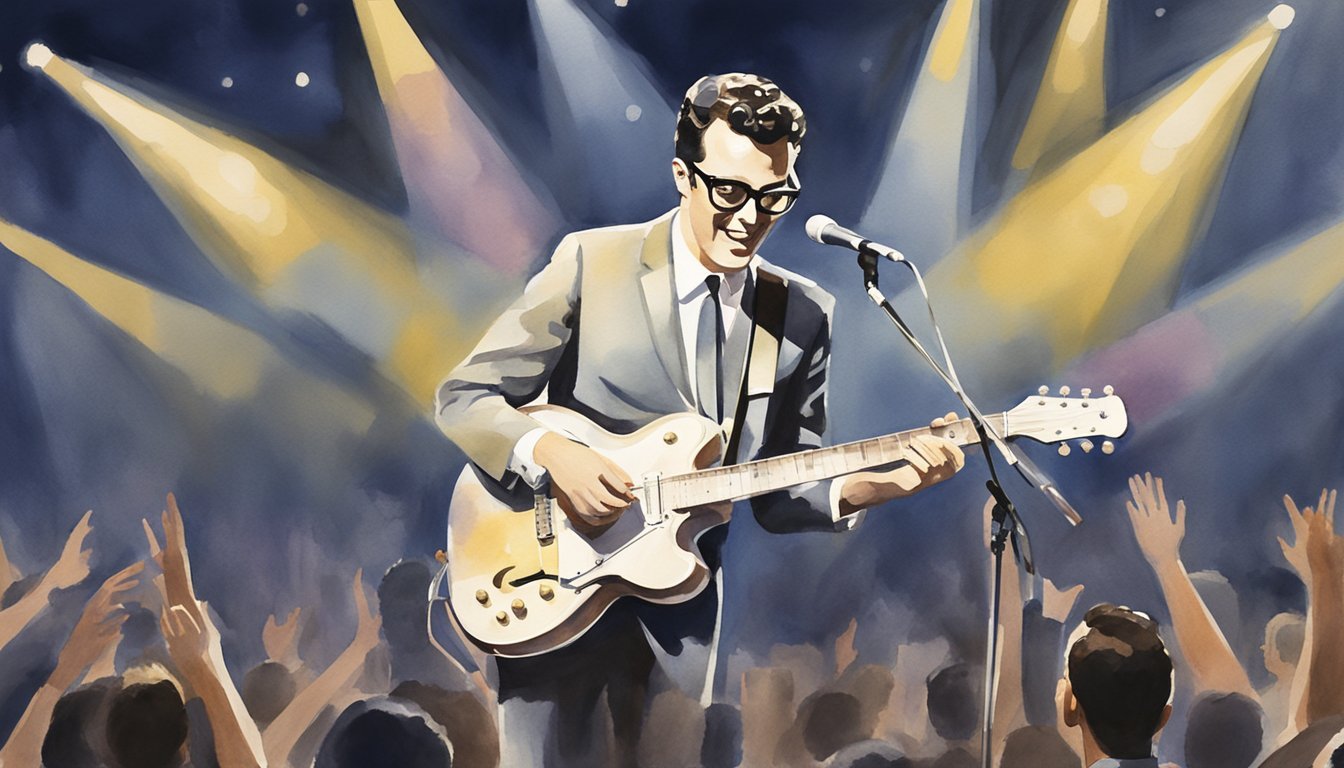Biography of Buddy Holly: Rock ‘n’ Roll Legend

Buddy Holly, born Charles Hardin Holley, was a trailblazing figure in mid-1950s rock and roll. His unique blend of catchy melodies and innovative guitar riffs made him one of the most influential figures in the genre.
Holly’s music resonated with fans across the globe, creating a lasting legacy that continues to inspire musicians today.

Growing up in Lubbock, Texas, during the Great Depression, Buddy Holly learned to play guitar and sing alongside his siblings.
His early exposure to gospel and country music, combined with his natural talent, formed the bedrock of his musical style.
Holly’s rise to fame was meteoric, marked by hit songs like “Peggy Sue” and “That’ll Be the Day” which still hold a special place in rock and roll history.
Tragically, Holly’s career was cut short when he died in a plane crash at the age of 22.
Despite his brief career, his impact on rock and roll is immeasurable, earning him posthumous recognition and influencing countless musicians.
For more secret insights 🌟 into spiritual knowledge, visit this link.
Key Takeaways
- Buddy Holly was a pioneering figure in rock and roll.
- His early life in Texas shaped his unique musical style.
- Holly’s influence continues despite his untimely death.
Early Life and Background
Buddy Holly, born Charles Hardin Holley, grew up in the vibrant town of Lubbock, Texas.
His early life was filled with music, influenced by family and the cultural sounds of West Texas.
Holly’s high school years helped shape his musical talents.
Childhood in Lubbock, Texas
Charles Hardin Holley was born on September 7, 1936, in Lubbock, Texas.
He was the youngest of four children in a musical family.
His mom nicknamed him “Buddy” early on.
Lubbock, during the Great Depression, was tough, but it was rich in musical traditions. 🎶
Buddy’s family, devout Baptists, often gathered to sing gospel hymns.
These early experiences with music in the family home fueled his passion for performing.
Buddy watched and learned as his older siblings played various instruments.
This background laid the foundation for his love for music.
Musical Influences
Growing up, Buddy Holly was influenced by a mix of gospel, country, and R&B. He started playing guitar at a young age and soon became quite skilled.
He drew inspiration from early rock ‘n’ roll icons like Elvis Presley and Chuck Berry.
He frequently listened to radio stations that played a blend of different genres, which broadened his musical tastes.
Buddy also got to know local musicians in West Texas, and this community shaped his sound.
His early collaborations with friends resulted in the formation of several small bands, honing his skills in front of small but supportive audiences.
High School Years
During his high school years, Buddy attended Lubbock High School.
Here, he continued to develop his musical abilities.
He participated in talent shows and other school events, where he gained attention for his unique style and energetic performances.
Buddy started his first band with friends from school, playing mostly country music.
Eventually, he transitioned to rock ‘n’ roll, captivated by the genre’s energy.
His time at high school wasn’t just about music, though.
He balanced his love for playing guitar with his studies, although music was always his true passion.
For those interested in more secret pursuits, explore the incredible world of secret spiritual knowledge.
Buddy Holly’s early life set the stage for his brief but impactful career in music.
His upbringing in Lubbock, Texas, and the experiences in high school all played a crucial role in shaping the rock legend he became.
Rise to Fame

Buddy Holly’s rise to fame was marked by the formation of The Crickets and securing his first record deal, which led to his hit songs and lasting influence on rock and roll.
Formation of The Crickets
Buddy Holly formed The Crickets in 1956. 🦗 At the time, Buddy was experimenting with a new sound that would stand out.
He teamed up with friends Jerry Allison (drums), Joe B. Mauldin (bass), and Niki Sullivan (rhythm guitar).
The band began practicing in Buddy’s garage and quickly developed a unique sound.
They combined rockabilly twang with catchy, upbeat melodies.
In 1957, they recorded “That’ll Be the Day,” which became their first major hit.
This song showcased their style and helped them gain national attention.
The Crickets’ formation was crucial for Buddy Holly.
The chemistry and talent within the group helped them create music that would shape the future of rock and roll.
First Record Deal
After forming The Crickets, Buddy Holly sought out a record deal. 🎸 In early 1956, he managed to sign with Decca Records.
However, his initial recordings with Decca didn’t do well.
Decca even dropped him after a year without any hit records.
This setback didn’t stop him.
Buddy continued to write music, and eventually, he signed with Brunswick Records under a new contract.
Under this label, his song “That’ll Be the Day” was re-recorded and went on to become a number one hit.
Following this success, Buddy Holly released more hits like “Peggy Sue,” solidifying his place in rock history.
His determination and perseverance paid off, leading to several top-ten hits and a significant influence on other musicians.
For more about Buddy Holly’s journey and secret spiritual knowledge, click here.
Mainstream Success and Hits
Buddy Holly experienced a swift rise in the music world.
His collaboration with legendary producer Norman Petty helped shape his sound, leading to multiple chart-topping singles.
Holly’s innovations in rock music influenced many artists and set new standards in the genre.
Collaboration With Norman Petty
Buddy Holly’s partnership with producer Norman Petty marked a turning point in his career. 🔊 Working at Petty’s studio in Clovis, New Mexico, Holly and The Crickets crafted some of their biggest hits.
Petty’s sophisticated production techniques brought a polished sound to Holly’s music.
During this period, they recorded classics such as “Peggy Sue” and “That’ll Be the Day.” The fusion of Holly’s energetic performance and Petty’s innovative recording methods resulted in a fresh, distinctive style that left a lasting impact on rock music.
These sessions also included “Rave On,” another iconic track that showcased Holly’s signature vocal delivery and guitar work. 🎸
Chart-Topping Singles
Buddy Holly’s singles dominated the charts in the late 1950s. “That’ll Be the Day” was a breakthrough, reaching number one on the Billboard Hot 100 in 1957.
Another hit, “Peggy Sue,” followed closely, becoming one of his most memorable songs.
Not only did it top the charts, but it also demonstrated Holly’s skillful guitar playing and catchy songwriting.
The song “Not Fade Away” was later covered by The Rolling Stones, further cementing Holly’s influence in rock music. 📈 The success of these songs was a testament to Holly’s talent and his ability to connect with a wide audience.
Innovations in Rock Music
Buddy Holly brought several innovations to the rock genre, setting trends that future musicians would follow.
He was one of the first to use overdubbing in his recordings, allowing for layered sound that was ahead of its time.
Holly also popularized the use of the Fender Stratocaster guitar in rock music.
His songwriting style, blending catchy melodies with heartfelt lyrics, became a template for many artists.
One notable example is the song “American Pie” by Don McLean, which pays homage to Holly and his contributions to music.
Buddy Holly’s creativity and technical skills helped transform rock music, leaving an indelible mark on the industry. 🌟 For a deeper dive into his contributions and other aspects of his life, check out this secret spiritual knowledge.
Music Style and Influence

Buddy Holly’s music style was a unique blend of rock ‘n’ roll, country, and blues.
Known for his innovative guitar techniques and heartfelt lyrics, Holly significantly shaped the future of rock music.
Blending Different Genres
Buddy Holly was a master at blending different music genres.
His songs often combined elements of rock ‘n’ roll, country, and blues.
This mix gave his music a fresh sound that was both energetic and soulful.
Holly’s ability to seamlessly mix these genres made his music stand out.
For instance, his hit “That’ll Be the Day” had rockabilly energy with a strong country influence.
Another example is “Everyday,” which displayed a softer, more melodic rock sound with a country touch.
These diverse influences made Holly a pioneer in rock music.
Guitar Techniques
Holly was a guitar innovator 🎸.
Known for his clean, bright guitar sound, he often used a Fender Stratocaster, which was uncommon at the time.
His use of up-tempo strumming and rhythmic patterns added a driving force to his music.
He also experimented with feedback and distortion, adding layers to his sound.
Songs like “Peggy Sue” showcased his energetic strumming and unique chord progressions.
Holly’s guitar work influenced many future rock guitarists, cementing his place in rock history.
Lyrical Content
Holly’s lyrics were simple yet profound.
His songs often revolved around love, heartbreak, and teenage experiences.
These relatable themes resonated deeply with young audiences.
For example, “Words of Love” captured the tenderness of young love, while “Not Fade Away” expressed a determined love that would last.
His straightforward, honest lyrics connected with listeners and helped popularize rock music.
Buddy Holly’s contributions remain significant in shaping modern rock, from his genre-blending style to his innovative guitar techniques and heartfelt lyrics.
He left an indelible mark on music history.
For an interesting read on secret spiritual knowledge, check this out! 🌟
Collaborations and Performance

Buddy Holly was known for his unique style and collaborations that left a mark on rock and roll.
His work with other musicians and his performances were both influential and memorable.
The Winter Dance Party Tour
The Winter Dance Party Tour took place in early 1959.
This tour was meant to boost Buddy Holly’s career after he split from his band, The Crickets.
On stage, Buddy performed alongside Ritchie Valens and The Big Bopper.
The tour faced many problems, including harsh winter weather and bus issues.
Despite these challenges, Buddy’s live performances were well-received by fans. 🎸
Tragically, the tour ended in disaster when Buddy, Ritchie Valens, and The Big Bopper died in a plane crash after a show in Clear Lake, Iowa.
This event is often called “The Day the Music Died.”
Association With Other Musicians
Buddy Holly also played with many famous musicians, such as Waylon Jennings and Elvis Presley.
Waylon Jennings was part of the Crickets for a short time.
He even gave up his plane seat on the ill-fated flight to The Big Bopper.
🥁 Buddy admired Elvis Presley and the two shared the stage on several occasions.
Elvis’s influence on Buddy was clear in his energetic performances and innovative guitar techniques.
Buddy’s ability to collaborate and connect with other artists made him a beloved figure in music.
He inspired countless musicians and left a lasting legacy in rock and roll.
For a fascinating dive into secret spiritual knowledge, check out this resource.
Tragic Plane Crash and Aftermath

On February 3, 1959, a small plane carrying Buddy Holly, Ritchie Valens, and The Big Bopper crashed near Clear Lake, Iowa.
Each of these musicians left a lasting mark on rock and roll, and their sudden deaths deeply affected the music world.
The Day the Music Died
In the early hours of February 3, 1959, Buddy Holly, Ritchie Valens, and The Big Bopper boarded a chartered Beechcraft Bonanza plane to avoid harsh travel conditions.
The plane crashed shortly after takeoff, killing everyone on board, including the pilot, Roger Peterson.
Buddy Holly’s bassist, Waylon Jennings, gave up his seat to The Big Bopper, who had the flu.
The crash location was near Clear Lake, Iowa, and it happened shortly after 12:55 a.m. This event is famously known as The Day the Music Died, a term popularized by Don McLean in his song “American Pie.” The tragedy struck the music world, as it lost three of its promising stars.
Impact on the Music Industry
The loss of Buddy Holly, Ritchie Valens, and The Big Bopper had a significant impact on the music industry.
Buddy Holly, known for hits like “Peggy Sue” and “That’ll Be the Day,” was only 22 years old.
His early death left fans and fellow musicians alike mourning a talent gone too soon.
Ritchie Valens was just 17 and had gained fame with songs like “La Bamba.” The Big Bopper, famous for his hit “Chantilly Lace,” also had a promising future cut short.
Their deaths brought a renewed focus on the safety of musicians while touring.
The crash galvanized the rock and roll community, prompting changes in travel policies and safety practices.
Fans and musicians still remember them fondly, and their music continues to inspire new generations.
The tragic event also led some to seek deeper understanding, including secret spiritual knowledge about life and destiny. 🎸🕊️
Posthumous Recognition

Buddy Holly’s influence on rock and roll didn’t end with his tragic death in 1959.
His legacy has continued to grow, marked by significant honors and tributes from artists and institutions around the world.
Induction into the Hall of Fame
Buddy Holly was inducted into the Rock and Roll Hall of Fame in 1986.
This honor recognized his groundbreaking work in the 1950s that helped shape the future of rock music.
His innovative style and songwriting were noted as influences on many artists, including The Beatles.
The Hall of Fame highlighted how his unique sound and techniques set the stage for future generations of musicians.
He also earned a spot on Rolling Stone’s list of “The 100 Greatest Artists of All Time.” This accolade reinforced his enduring impact on the music industry.
His early work with his band, The Crickets, was particularly noted for its contribution to the genre.
Legacy and Tributes
Many artists have paid tribute to Buddy Holly over the years.
The Beatles often cited him as a major influence on their music.
Paul McCartney once said that seeing Holly perform live inspired him to start writing his own songs.
Holly’s distinct style can be heard in many of their early tracks, such as “That’ll Be the Day,” which they covered.
Years after his death, Holly received a star on the Hollywood Walk of Fame.
On what would have been his 75th birthday, a ceremony was held to honor his contributions to music.
Fans gathered outside the Capitol Records Building to celebrate his life and career.
In addition to these tributes, various films, books, and documentaries have chronicled Holly’s life and career, further solidifying his place in music history.
For those interested in how artists like Holly can influence deeper knowledge, check this site for insights. 🎸
Influence on Other Musicians
Buddy Holly’s work had a huge impact on the music world, inspiring big names like The Beatles, The Rolling Stones, Bob Dylan, and Don McLean.
These artists found something special in the way Holly created and performed his music.
The Beatles and The Rolling Stones
The Beatles were so inspired by Buddy Holly that they covered many of his songs.
Paul McCartney once said that Holly’s “That’ll Be the Day” was one of the first songs he ever performed.
The group even named their band partly in tribute to Holly’s band, The Crickets.
They wanted a name that was like theirs but a bit different, hence The Beatles with an ‘A’.
The Rolling Stones also found Holly’s music incredibly influential.
Keith Richards admired Holly’s guitar work and songwriting.
One of their early hits, “Not Fade Away,” was a cover of a Buddy Holly song.
Mick Jagger even mentioned that Holly showed them how a band could write their own songs and be self-contained. 🌟
Bob Dylan and Don McLean
Bob Dylan greatly admired Buddy Holly.
Dylan saw Holly perform live just days before Holly’s tragic death.
This concert left a lasting impression on him.
Dylan has often noted that Holly’s songwriting influenced his style.
Dylan’s incorporation of harmonica and guitar was somewhat modeled after Holly’s style.
Don McLean is famous for his song “American Pie,” which references “the day the music died”.
This was about the plane crash that killed Buddy Holly.
The legacy Holly left behind inspired McLean’s songwriting, helping him craft songs that were emotional and poetic.
McLean has often expressed how deeply Holly’s music has affected him personally and professionally. ✨
Personal Life and Relationships
Buddy Holly’s personal life was highlighted by his marriage to Maria Elena Santiago and his relationships with family and friends in West Texas.
These connections had a significant impact on his life and career.
Marriage to Maria Elena Santiago
Buddy Holly married Maria Elena Santiago on August 15, 1958.
They met in New York City, where Maria Elena worked as a receptionist at a music publishing company.
After just a whirlwind two-week romance, they decided to tie the knot.
The couple’s brief time together was marked by their deep love and commitment.
Maria Elena often accompanied Buddy on tours and was supportive of his music career.
She remained a significant figure in his life until his tragic death in a plane crash on February 3, 1959.
Family and Friends
Growing up in Lubbock, Texas, Buddy Holly had a close-knit family.
He was the youngest of four children.
His siblings played a big role in his early musical development, often playing instruments and singing together. 🎸
Buddy’s circle of friends in West Texas included other musicians who shared his passion for rock and roll.
One notable friendship was with fellow musician Waylon Jennings, who later became a country music star.
Buddy’s relationships with his family and friends helped shape his music and inspired many of his songs.
For more on secret spiritual knowledge, check this link.
Cultural Impact and Modern Recognition
Buddy Holly’s impact on music and culture continues to resonate today.
From books and documentaries to museums and music festivals, his legacy endures in numerous ways.
Books and Documentaries 📚🎥
Many books capture Buddy Holly’s life and legacy.
One notable biography is “Buddy Holly: A Biography,” which dives into his life and achievements.
Documentaries like “The Buddy Holly Story” feature interviews, rare footage, and performances.
These sources help keep Holly’s memory alive and introduce new generations to his work.
Such media not only preserve his story but also highlight his influence on later musicians, keeping his spirit alive in popular culture.
Museums and Memorials 🏛️🕊️
The Buddy Holly Center in Lubbock, Texas, stands as a testament to his lasting influence.
The center has various exhibits, including personal items, memorabilia, and interactive displays.
Visitors can learn about Holly’s career, his contributions to rock and roll, and the impact he had on the music industry.
Another significant landmark is the memorial in Clear Lake, Iowa, near the site of the plane crash that took his life.
These places serve as pilgrimage sites for fans and music lovers, providing a space to honor his memory and legacy.
Music Festivals and Events 🎶🎤
Numerous music festivals celebrate Buddy Holly’s contributions to rock and roll.
Events like the annual Winter Dance Party in Clear Lake, Iowa, attract fans from around the world.
These gatherings feature performances by artists influenced by Holly, ensuring his music continues to inspire.
Festivals not only celebrate his work but also provide a platform for new talents.
By bridging past and present, these events help maintain Buddy Holly’s significance in the cultural landscape, making sure his legacy endures.
He remains a key figure in rock and roll history, resonating through various media and events.
For more on hidden knowledge that can enhance your life, visit this linked page.






